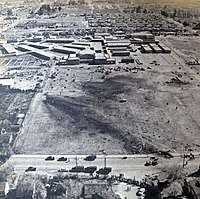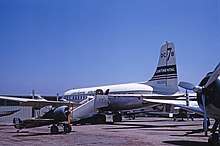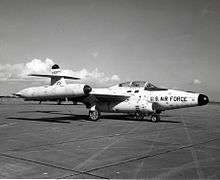1957 Pacoima mid-air collision
On January 31, 1957, a Douglas DC-7B operated by Douglas Aircraft Company was involved in a mid-air collision with a United States Air Force Northrop F-89 Scorpion and crashed into the schoolyard of Pacoima Junior High School located in Pacoima, a suburb in the San Fernando Valley of Los Angeles, California.[1][2][3]
 Crash site | |
| Accident | |
|---|---|
| Date | January 31, 1957 |
| Summary | Mid-air collision |
| Site | Over the San Fernando Valley, California, United States 34.25064°N 118.42607°W |
| Total fatalities | 8 |
| Total injuries | 78 (estimated) |
| First aircraft | |
 | |
| Type | Douglas DC-7B |
| Operator | Douglas Aircraft Company |
| Registration | N8210H |
| Flight origin | Santa Monica Airport, Santa Monica, California, United States |
| Destination | Santa Monica Airport, Santa Monica, California, United States |
| Passengers | 0 |
| Crew | 4 |
| Fatalities | 4 |
| Injuries | 0 |
| Survivors | 0 |
| Second aircraft | |
 A Northrop F-89J Scorpion of the Wisconsin Air National Guard's 176th Fighter Interceptor Squadron in October 1972. | |
| Type | Northrop F-89J Scorpion |
| Operator | United States Air Force |
| Registration | 52-1870 |
| Flight origin | Palmdale, California, United States |
| Destination | Palmdale, California, United States |
| Passengers | 0 |
| Crew | 2 |
| Fatalities | 1 |
| Injuries | 1 |
| Survivors | 1 |
| Ground casualties | |
| Ground fatalities | 3 |
| Ground injuries | 74 (estimated) |
Accident
The DC-7B, earmarked for delivery to Continental Airlines, took off from the Santa Monica Airport at 10:15 a.m. on its first functional test flight, with a crew of four Douglas personnel aboard. Meanwhile, in Palmdale to the north, a pair of two-man F-89J fighter jets took off at 10:50 a.m. on test flights, one that involved a check of their on-board radar equipment. Both jets and the DC-7B were performing their individual tests at an altitude of 25,000 feet in clear skies over the San Fernando Valley when, at about 11:18 a.m., a high-speed, near-head-on midair collision occurred. Investigators were later able to determine that the two aircraft most likely converged at a point over an area northeast of the Hansen Dam spillway.[4]
Following the collision, Curtiss Adams (1929-2002), the radarman aboard the eastbound twin-engine F-89J Scorpion, was able to bail out of the stricken fighter jet and, despite incurring serious burns, parachuted to a landing onto a garage roof in Burbank, breaking his leg when he fell to the ground. The fighter jet's pilot, Roland E. Owen, died when the aircraft plummeted in flames into La Tuna Canyon in the Verdugo Mountains.[5]
The DC-7B, with a portion of its left wing sheared off, remained airborne for a few minutes then rolled to the left and began an uncontrollable, spiraling, high-velocity dive earthward. In doing so, it began raining debris onto the Pacoima neighborhoods below as the aircraft began to break apart. Seconds later, part of the hurtling wreckage slammed onto the grounds of the Pacoima Congregational Church, killing all four Douglas crewmen aboard while the major portions fell onto the adjacent playground of Pacoima Junior High School. On the school playground, where some 220 boys were just ending their outdoor athletic activities, the wreckage broke upon impact into numerous pieces and intense fires began due to the aircraft's fuel and oil. Distinct craters were made in the playground by each of the four engines and the main center fuselage section. Two students, Ronnie Brann, 13, and Robert Zallan, 12, were struck and killed by this wreckage and debris. A third gravely injured student, Evan Elsner, 12, died two days later in a local hospital. An estimated 75 more students on the school playground suffered injuries ranging from critical to minor.[6] Future rock 'n' roll legend Ritchie Valens was a 15-year-old student at Pacoima Junior High School at the time of the disaster, but was not at school that day because he was attending the funeral of his grandfather.
The collision was blamed on pilot error and the failure of both aircraft crews to exercise proper “see and avoid” procedures regarding other aircraft while operating under visual flight rules (VFR). The crash also prompted the Civil Aeronautics Board (CAB) to set restrictions on all aircraft test flights, both military and civilian, requiring that they be made over open water or specifically approved sparsely populated areas.[7]
References
- Hill, Gladwyn. "7 Die as Planes Collide and One Falls in Schoolyard; PLANES COLLIDE, SCHOOL YARD HIT Roar Alerts Students 'Everything on Fire' Witness Describes Crash." The New York Times. Friday February 1, 1957. Page 1. Retrieved on February 3, 2010. "Wreckage of airliner falls into school yard at Pacoima, Calif."
- "31-JAN-1957 Douglas DC-7B N8210H." Aviation Safety Network. Retrieved on February 3, 2010.
- "7 KILLER, 74 HURT IN SCHOOL AIR CRASH." [sic] Los Angeles Times. February 1, 1957. Start page 1. 5 pages. Retrieved on February 3, 2010.
- C.A.B. DOCKET # SA-323, FILE #2-0020, DATE ADOPTED November 22, 1957, p. 5.
- C.A.B. DOCKET # SA-323, FILE #2-0020, DATE ADOPTED November 22, 1957, p. 1.
- http://www.joangushin.net/crashpictures.html
- C.A.B. DOCKET # SA-323, FILE #2-0020, DATE ADOPTED November 22, 1957, p. 16.
External links
- ASN Aircraft accident Douglas DC-7B N8210H Sunland, CA – Aviation Safety Network
- CAB Accident report docket # SA-323, November 26, 1957
- We Remember We Heal – Joan Gushin website
- Test Planes Collide Over School, 7 Die – Joan Gushin website
- List of injuries, Pacoima JHS – Joan Gushin website
- CBS Radio Workshop, Episode "Heaven Is In the Sky"